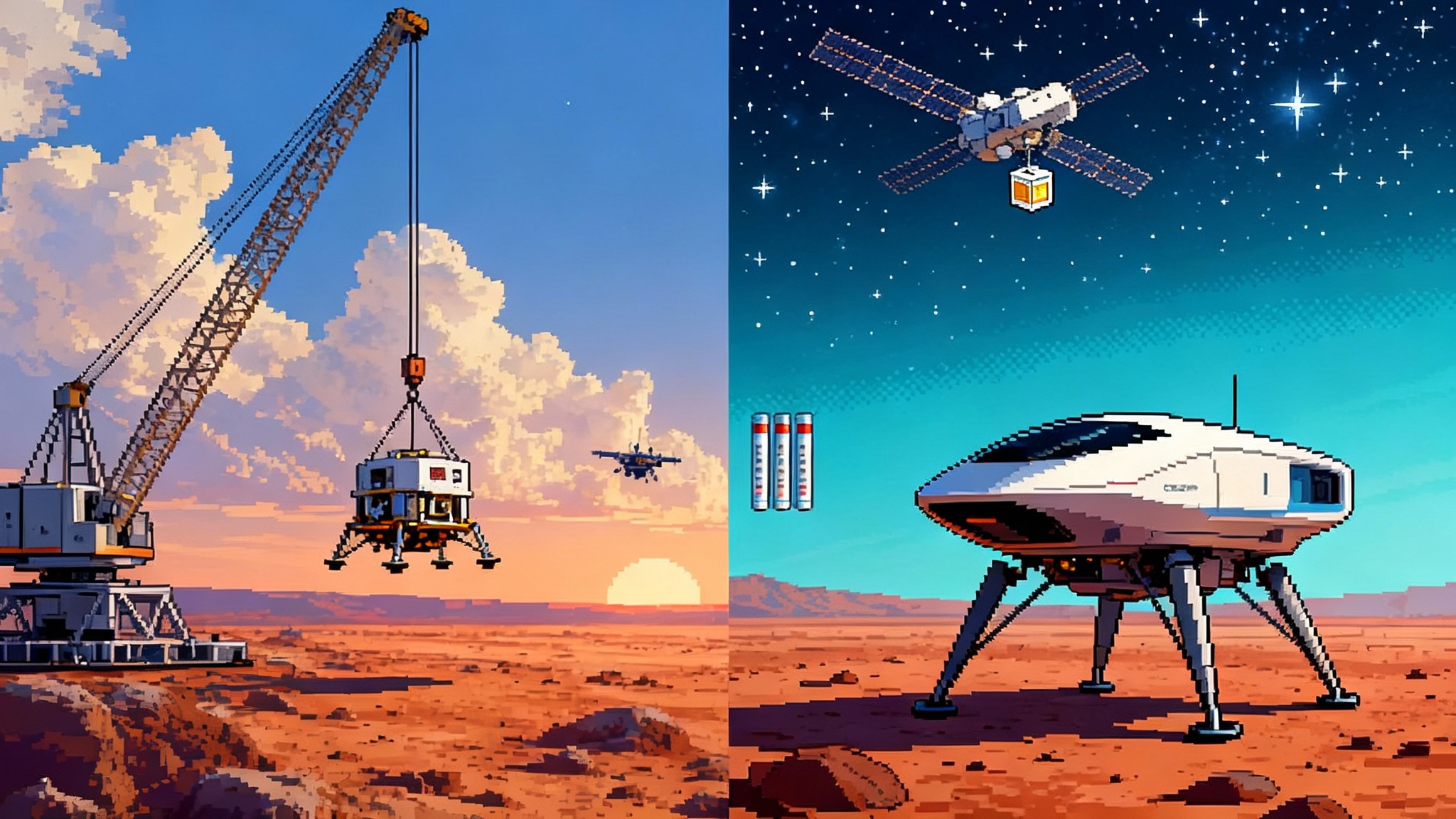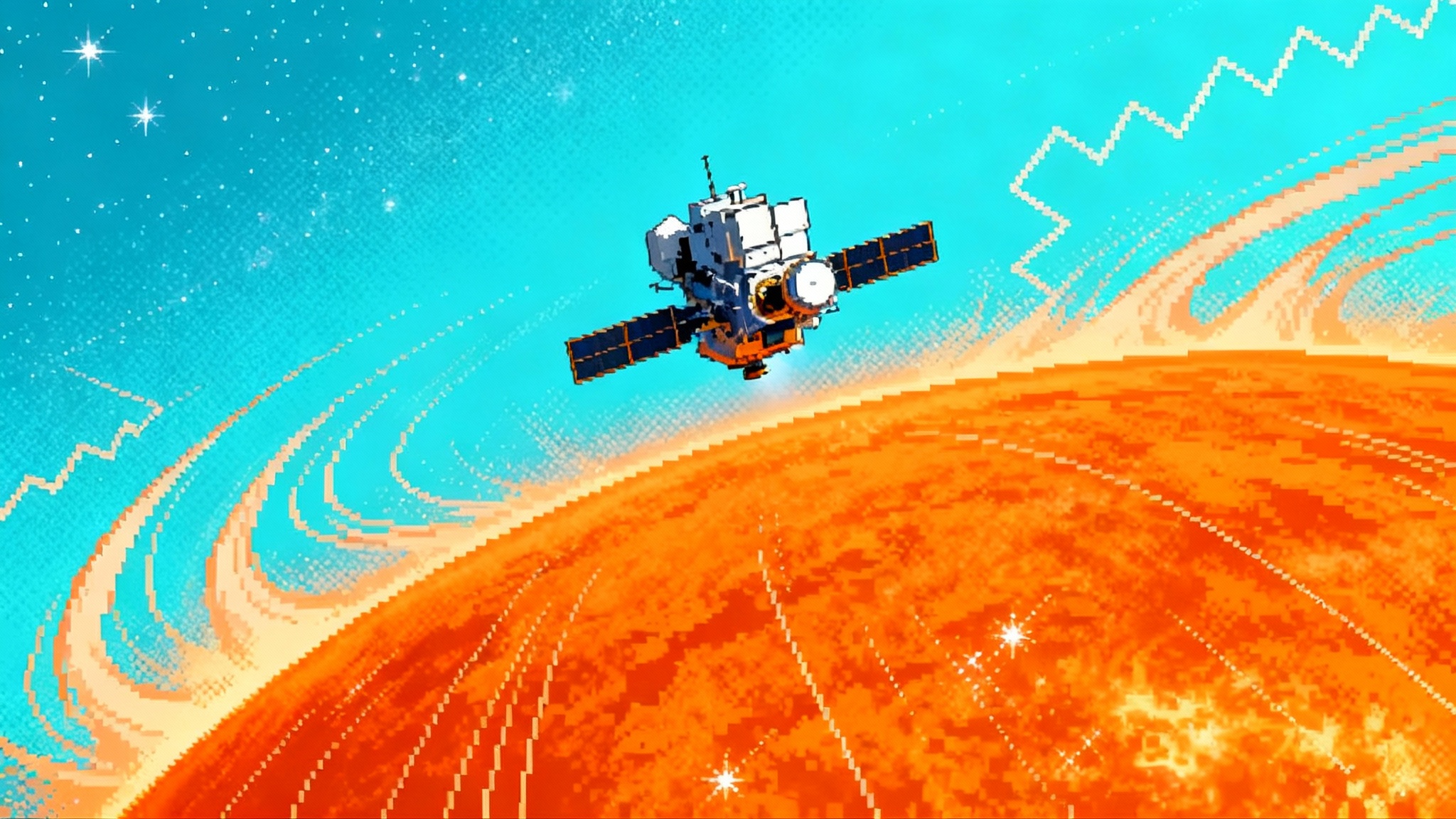NASA’s 2025 Mars sample return reset, explained
NASA rebooted Mars Sample Return in 2025 with a two-architecture race and new fixed-price roles for industry. Here is what changed, why it matters for cost, schedule, and risk, and what the science payoff could be.

What changed in 2025
NASA’s Mars Sample Return effort entered 2025 with a clean sheet and a new mindset. Instead of pushing one complex, multivehicle design uphill, the agency announced a two-track plan and will carry both concepts through formulation before down-selecting to one in the second half of 2026. In parallel, NASA asked industry to bring forward firm-priced concepts that could deliver the Perseverance rover’s carefully cached cores sooner and at lower risk. The pivot acknowledges that the original path was unaffordable and too slow relative to the scientific payoff.
In the new approach NASA is exploring two landing architectures for the campaign’s single landed platform on Mars. One option leans on the sky crane heritage that placed Curiosity and Perseverance on the surface. The other invites commercially led delivery of the payload platform, with NASA evaluating industry’s best ideas while it carries the government-led option in parallel. The agency framed this as competition inside the architecture itself, not just among vendors. NASA announced a two-track plan and set the expectation that only one will proceed after 2026.
Under either option, several design pivots stand out:
- A smaller Mars Ascent Vehicle rides on a more compact landed platform, reducing mass and complexity compared to the earlier concept.
- Solar arrays are replaced by a radioisotope power system, trading dust-season vulnerability for steady power and heat.
- The sample loading system is redesigned so tubes go into the orbiting container in a way that limits dust on the exterior, simplifying backward planetary protection implementation when the container reaches orbit.
- The orbiting sample container will carry roughly 30 tubes, aligning the flight system’s capacity with the most scientifically valuable subset of the cache.
These changes reframe the entire campaign: fewer bespoke elements, a shorter surface timeline, and interfaces that are simpler to certify under strict planetary-protection rules.
Why two landing architectures in parallel
Pursuing two architectures is as much about governance as it is about engineering. It forces a true trade between a government-led, heritage-heavy path and a commercially driven path that could be cheaper or faster, but that shifts accountability and risk differently. Keeping both alive through formulation has three intended benefits:
- Competitive pressure: Teams must demonstrate credible cost, schedule, and risk margins, not just technical elegance.
- Option value: If a key technology, supplier, or test fails on one path, the other can absorb the mission without a cold restart.
- Better cost insight: Parallel design reviews and independent cost estimates sharpen NASA’s ability to choose an executable plan.
This is essentially the Commercial Crew lesson applied to a flagship science mission. By encouraging diversity in entry, descent, and landing, and in how the payload is integrated and tested, NASA increases the chance that at least one path meets the bar without consuming the entire planetary science budget.
The new industry role and fixed-price bids
NASA did more than ask for ideas. It put real money behind rapid studies and signaled that later procurements would favor firm-fixed-price awards where appropriate. In 2024 the agency issued 90-day study contracts to multiple companies under a fixed-price model and invited them to reimagine either the full campaign or critical elements such as the lander, ascent vehicle, or Earth return system. NASA described these as firm-fixed-price study contracts to industry and labs to find affordable, faster options for returning Perseverance’s samples, with selections later informing the 2025 reset and down-select in 2026. You can read NASA’s description of those contracts and participants in its update on firm-fixed-price study contracts to industry.
Fixed-price does not mean fixed-risk. It means NASA buys defined deliverables at a set price, with the contractor bearing more of the cost overrun risk in exchange for more freedom to design and manage. For MSR, that likely applies to well-bounded spacecraft or services where industry has strong heritage. Cost-plus will still appear where risk is irreducible or where NASA must retain deep oversight, such as sample containment and planetary protection certification.
Could this pull the return date forward
NASA’s explicit goal is to move sample return into the 2030s rather than toward the end of the next decade. The dual-architecture strategy is the enabler. Here is how it could work in practice:
- Fewer elements to develop and test. A single landed platform with an integrated ascent vehicle reduces parallel development lines and the number of inter-element interfaces that historically drive schedule slips.
- Matured entry, descent, and landing. The government-led option leverages the sky crane stack that has already flown on Mars twice, shrinking the EDL test campaign. If the commercial option proves credible and earlier, NASA can pivot, but it does not have to bet the mission on a single EDL approach.
- Streamlined surface ops. Radioisotope power avoids dust-season pauses and eliminates large, fragile solar arrays, allowing simpler deployment and thermal control, and potentially a shorter surface campaign to load and launch the samples.
- Simplified planetary protection flow. By minimizing external dust on the orbiting sample container and reducing the number of handoffs, the team can cut time from contamination control reviews and verification testing.
None of this guarantees an early return. It does, however, remove known schedule killers and gives the program authority options during the inevitable surprises.
Where will cost and risk actually come down
- Integration and test: A smaller landed platform and a compact ascent vehicle cut thermal-vacuum campaigns and facilities time. They also reduce the mass growth risk that often explodes budgets late in development.
- Fewer new starts: Reusing proven hardware and processes lowers nonrecurring engineering. For example, heritage robotic arms and sample handling mechanisms come with known performance envelopes and qualification paths.
- Contract structure: Where NASA can define interfaces cleanly, fixed-price procurements bound the government’s exposure to overruns and create incentives to avoid requirements creep.
- Mission operations: Shorter surface timelines and a single capture in Mars orbit lower the operations burn rate, one of the hidden drivers in past plans.
Risk is not eliminated. The Mars Ascent Vehicle is still a first. Autonomous rendezvous and capture in Mars orbit remain among the mission’s hardest tasks. The new plan mitigates by narrowing the scope of what must be invented and by keeping redundant architectural routes alive until the last responsible moment.
What happens to ESA’s Earth Return Orbiter
Both architectures depend on the European Space Agency’s Earth Return Orbiter. ERO will perform the rendezvous in Mars orbit, capture the orbiting sample container, and bring it back to Earth with NASA’s capture, containment, and return hardware riding aboard. NASA’s 2025 reset kept ERO at the center of the plan, and ESA has been evaluating the updated approach while continuing its development work. Keeping ERO constant across both landing options anchors the campaign to a single, well-scoped orbital segment while competition plays out on the surface.
For ESA, a stable role also protects industrial planning. The payloads and GNC needed for Mars-orbit capture and Earth return are unique European contributions. As NASA pares back surface complexity, the relative importance of ERO grows. That in turn sharpens joint interfaces, like the docking and sealing sequences that will be certified to restricted Earth-return standards.
Planetary protection and the redesigned loading chain
Backward planetary protection is the quiet driver of many design choices. The orbiting sample container must arrive at Earth as clean on the outside as when it left Mars orbit. The 2025 plan’s revised loading system places the sealed tubes into the container in a way that reduces external dust. Fewer surface handoffs mean fewer paths for contamination. The goal is to simplify the proof that the outer surfaces of the return system never contacted martian material.
Once the container is tucked inside the Earth Entry System, the campaign transitions to restricted Earth return. That means layered containment, validated sterilization where appropriate, and receiving in a purpose-built facility that combines high biocontainment with ultraclean lab practices. The facility and its analytical workflows must let scientists open the tubes without compromising biosecurity or the scientific value of the samples. Designing the mission around that end state from the start is one reason the team has converged on a smaller number of tubes and a cleaner loading chain.
What is at stake scientifically
Perseverance did not just core rocks. It assembled a deliberately diverse archive.
- Igneous rocks from Jezero’s floor can pin down the ages of key geologic events with laboratory chronometers, providing absolute dates that remote sensing cannot deliver.
- Deltaic mudstones and sandstones capture ancient lake and river environments, preserving organics, isotopic signatures, and textures that may record habitability and potential biosignatures.
- Carbonate-bearing samples can reveal water chemistry and climate history and serve as stable archives for carbon isotopes.
- Regolith and atmospheric samples help scientists understand present-day surface processes, radiation exposure, and the transport of salts and oxidants that affect preservation of organics.
On Earth, researchers can subject these cores to analytical techniques that no rover can carry: atom-probe tomography, nanometer-scale secondary ion mass spectrometry, high-precision radiometric dating, and complex organic separations. Lessons from Bennu’s 2025 sample haul show how carefully curated returns can reshape origin-of-life science and planetary history.
Budget reality and collateral effects across the portfolio
The 2025 reset is as much about protecting the rest of planetary science as it is about MSR itself. The prior plan’s costs and schedule uncertainty threatened to squeeze missions like the Titan rotorcraft, near-Earth object surveyors, and Venus orbiters and probes. NASA’s stated intent with the two-track, competition-forward approach is to keep MSR within a budget wedge that does not consume future new starts.
Three practical shifts help:
- A smaller, better-bounded lander and ascent vehicle narrows cost risk bands that were previously wide and asymmetric.
- Fixed-price elements where interfaces are stable convert some unknowns into knowns earlier.
- A later down-select concentrates resources on one executable plan rather than spreading thin across an unwieldy architecture.
There will still be hard tradeoffs in annual appropriations, especially in 2026 when NASA commits to a single plan. But the redesigned campaign has a credible path to coexist with other priorities rather than dominate them.
How roles and responsibilities could reshape
- NASA: Owns mission integration, planetary protection certification, sample science planning, and the Mars Ascent Vehicle test strategy. Continues to lead the government-led landing option through formulation.
- ESA: Delivers Earth Return Orbiter and works jointly on capture, containment, and return interfaces, as well as sample science planning and early receiving-facility coordination.
- Industry: Competes to provide either the landed delivery and integration stack, specific flight elements, or both, under fixed-price where feasible. Brings heritage in propulsion, reentry systems, and autonomous rendezvous to reduce government nonrecurring cost.
This division allows each partner to play to strengths. It also sets up a governance model similar to commercial cargo and crew, where NASA writes safety and performance standards, and industry innovates within those guardrails.
Signals for the future of Mars exploration
The reboot points to a more modular, competition-driven Mars program.
- Technology readiness for human missions: A flight-proven Mars ascent, autonomous orbital rendezvous at Mars, laser communications to Mars as shown by DSOC’s 218-million-mile link, and a clean Earth-entry chain are all human mission precursors. MSR becomes a proving ground, not a detour.
- Sustainable cadence: A simpler architecture that can be bought and built on predictable budgets creates room for follow-on missions, including networked weather stations or focused astrobiology landers. That commercial posture echoes insights from the New Glenn and NASA Mars moment.
- International partnership model: With ERO as a stable spine and NASA defining certification protocols, future Mars missions can mix and match national and commercial contributions without re-architecting from scratch.
If the down-select in 2026 picks a design that keeps costs stable and schedules credible, sample return in the 2030s becomes more than a hope. It becomes a cornerstone for how the United States, Europe, and commercial space will explore Mars together.
What to watch next
- The maturation of both landing options through key design reviews in 2025 and 2026.
- How NASA structures the first major fixed-price procurements for flight elements and what risk posture it demands.
- ESA’s progress on ERO’s capture and return systems as joint interface tests get scheduled.
- Facility plans and standards for receiving and curating the samples, which must be agreed well before launch.
NASA’s 2025 reset does not make Mars Sample Return easy. It does make it executable. The dual-architecture competition, combined with targeted fixed-price industry roles, is the most credible path yet to bring Jezero’s treasure to Earth while keeping the rest of planetary science moving forward.








